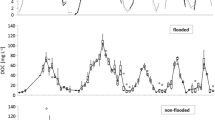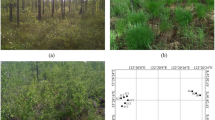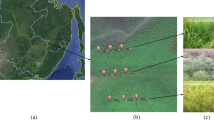Abstract
This study aimed to understand the seasonal and spatial variations of N2O emissions from newly created littoral marshes in the drawdown area of the Three Gorges Reservoir (TGR), China. We measured N2O emissions at 10-day intervals during the growing season (early July to late September) in 2008. N2O emissions were measured with static chambers in four typical vegetation stands. The results showed great spatial variations of N2O emissions among the four stands. The greatest N2O emissions (0.052 ± 0.063 mg N2O m−2 h−1) were from Scirpus triqueter stand, while the lowest N2O emissions (0.020 ± 0.020 mg N2O m−2 h−1) were from Typha angustifolia stand. To such spatial variations in N2O emissions, standing water depths and soil water content may be important explaining factors. Besides spatial variations, we also found significant temporal variations of N2O emissions in this area. The temporal variation of N2O emissions in the growing season was not found significantly related to any measured factor in the study. However, based on principal component analysis, we consider it partly caused by thermal conditions and the marked temporal variation of the standing water depth in the growing season, which to some degree influenced the process of denitrification and N2O emissions. These results about TGR enable us to make a more reasonable estimate of N2O emissions from large dam reservoirs, particularly those with a large drawdown area in the growing season in an agricultural landscape.





Similar content being viewed by others
References
Chen, H., Yao, S. P., Wu, N., Wang, Y. F., Luo, P., Tian, J. P., et al. (2008). Determinants influencing seasonal variations of methane emissions from alpine wetlands in Zoige Plateau and their implications. Journal of Geophysical Research, 113, D12303. doi:10.1029/2006JD008072.
Denman, K. L., Brasseur, G., Chidthaisong, A., Ciais, P., Cox, P. M., Dickinson, R. E., et al. (2007). Couplings between changes in the climate system and biogeochemistry. In S. Solomon, D. Qin, M. Manning, Z. Chen, M. Marquis, K. B. Averyt, et al. (Eds.), Climate Change 2007: the physical science basis. Contribution of working group I to the fourth assessment report of the intergovernmental panel on climate change (pp. 499–587). Cambridge: Cambridge University Press.
Dhondt, K., Boeckx, P., Hofman, G., & Van Cleemput, O. (2004). Temporal and spatial patterns of denitrification enzyme activity and nitrous oxide fluxes in three adjacent vegetated riparian buffer zones. Biology and Fertility of Soils, 40, 243–251.
Forster, P., Ramaswamy, V., Artaxo, P., Berntsen, T., Betts, R., Fahey, D. W., et al. (2007). Changes in atmospheric constituents and in radiative forcing. In S. Solomon, D. Qin, M. Manning, Z. Chen, M. Marquis, K. B. Averyt, et al. (Eds.), Climate change 2007: the physical science basis. Contribution of working group I to the fourth assessment report of the intergovernmental panel on climate change. Cambridge: Cambridge University Press.
Groffman, P. M., Gold, A. J., & Addy, K. (2000). Nitrous oxide production in riparian zones and its importance to national emission inventories. Chemosphere. Global Change Science, 2, 291–299.
Hefting, M. M., Bobbink, R., & De Caluwe, H. (2003). Nitrous oxide emission and denitrification in chronically nitrate-loaded riparian buffer zones. Journal of Environment Quality, 32, 1194–1203.
Hefting, M., Clément, J. C., Dowrick, D., Cosandey, A. C., Bernal, S., Cimpian, C., et al. (2004). Water table elevation controls on soil nitrogen cycling in riparian wetlands along a European climatic gradient. Biogeochemistry, 67, 113–134.
Heincke, M. M., & Kaupenjohann, M. (1999). Effects of soil solution on the dynamics of N2O emissions: a review. Nutrient Cycling in Agroecosystems, 55, 133–157.
Holland, E. A., Braswell, B. H., Sulzman, J., & Lamarque, J. F. (2005). Nitrogen deposition onto the United States and Western Europe: a synthesis of observations and models. Ecological Applications, 15, 38–57.
Hutchinson, G. L., & Mosier, A. R. (1981). Improved soil cover method for field measurement of nitrous oxide fluxes. Soil Science Society of America Journal, 45, 311–316.
Huttunen, J. T., Alm, J., Liikanen, A., Juutinen, S., Larmola, T., Hammar, T., et al. (2003a). Fluxes of methane, carbon dioxide and nitrous oxide in boreal lakes and potential anthropogenic effects on the aquatic greenhouse gas emissions. Chemosphere, 52, 609–621.
Huttunen, J. T., Juutinen, S., Alm, J., Larmola, T., Hammar, T., Silvola, J., et al. (2003b). Nitrous oxide flux to the atmosphere from the littoral zone of a boreal lake. Journal of Geophysical Research, 108(D14), 4421. doi:10.1029/2002JD002989.
Lu, R. K. (Ed), (1999). Analytical methods of soil agrochemistry. Beijing: Chinese Agriculture Science and Technology Press.
Mitsch, W. J., Lu, J. J., Yuan, X. Z., He, W. S., & Zhang, L. (2008). Optimizing ecosystem services in China. Science, 322, 528–528.
Mosier, A., & Delgado, J. A. (1997). Methane and nitrous oxide fluxes from grasslands in Western Puerto Rico. Chemosphere, 35, 2059–2082.
Mosier, A. R., Schimel, D. S., Valentine, D. W., Bronson, K. F., & Parton, W. J. (1991). Methane and nitrous oxide fluxes in native, fertilized, and cultivated grasslands. Nature, 335, 330–332.
Naiman, R. J., Bunn, S. E., Nilsson, C., Petts, G. E., Pinay, G., & Thompson, L. C. (2002). Legitimizing fluvial ecosystems as users of water: an overview. Environmental Management, 30, 455–467.
Nilsson, C., & Svedmark, M. (2002). Basic principles and ecological consequences of changing water regimes: riparian plant communities. Environment Management, 30, 468–480.
Paludan, C., & Blicher-Mathiesen, G. (1996). Losses of inorganic carbon and nitrous oxide from a temperate freshwater wetland in relation to nitrate loading. Biogeochemistry, 35, 305–326.
Schnabel, R. R., & Stout, W. L. (1994). Denitrification loss from two Pennsylvania floodplain soils. Journal of Environment Quality, 23, 344–348.
Silvan, N., Regina, K., Kitunen, V., Vasander, H., & Laine, J. (2002). Gaseous nitrogen loss from a restored peatland buffer zone. Soil Biology & Biochemistry, 34, 721–728.
Sovik, A., & Klove, B. (2007). Emission of N2O and CH4 from a constructed wetland in southeastern Norway. Science of the Total Environment, 380, 28–37.
Stone, R. (2008). Three Gorges Dam: into the unknown. Science, 321, 628–632.
Van Cleemput, O. (1998). Subsoils: chemo- and biological denitrification. N2O and N2 emissions. Nutrient Cycling in Agroecosystems, 52, 187–194.
van den Heuvel, R. N., Hefting, M. M., Tan, N. C. G., Jetten, M. S. M., & Verhoeven, J. T. A. (2008). N2O emission hotspots at different spatial scales and governing factors for small scale hotspots. Science of the Total Environment. doi:10.1016/j.scitotenv.2008.11.010.
Wang, H., Wang, W., Yin, C., Wang, Y., & Lu, J. (2006). Littoral zones as the “hotspots” of nitrous oxide (N2O) emission in a hyper-eutrophic lake in China. Atmospheric Environment, 40, 5522–5527.
Wu, J. G., Huang, J. H., Han, X. G., Xie, Z. Q., & Gao, X. M. (2003). Three-Gorges Dam—experiment in habitat fragmentation? Science, 300, 1239–1240.
Wu, J. G., Huang, J. H., Han, X. G., Gao, X. M., He, F. L., Jiang, M. X., et al. (2004). The Three Gorges Dam: an ecological perspective. Frontiers in Ecology and the Environment, 2, 241–248.
Acknowledgements
This study was financially supported by National Natural Foundation of China (40671181 and 90511008), Chinese Academy of Sciences (KZCX2-YW-418), Natural Science Foundation Project of CQ CSTC (2009BB7182). Wan XIONG, an expert of ESP, was thanked for her patient help in writing and editing. We must give personnel thanks to Mr. Meng WANG for his help with gas sample analysis and Mr. Fei YAO and Mr. Yuyuan WU for their assistance in gas sampling. The anonymous reviewer was thanked for his or her detailed evaluation about our manuscript and constructive suggestion on statistics.
Author information
Authors and Affiliations
Corresponding author
Rights and permissions
About this article
Cite this article
Chen, H., Yuan, X., Gao, Y. et al. Nitrous Oxide Emissions from Newly Created Littoral Marshes in the Drawdown Area of the Three Gorges Reservoir, China. Water Air Soil Pollut 211, 25–33 (2010). https://doi.org/10.1007/s11270-009-0277-4
Received:
Accepted:
Published:
Issue Date:
DOI: https://doi.org/10.1007/s11270-009-0277-4




